
This edition of Directions in Highway Safety, GHSA's member newsletter, features details on the GHSA 2022 Annual Meeting, recent publications, new grant funding and updates on current projects.
Quick Links: Cover Story | Executive Director's Report | From Washington | State of the States | Did You Know? | From Our Perspective
GHSA 2022 Annual Meeting Heads to Louisville
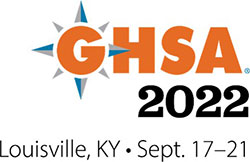 With traffic fatalities and dangerous driving on the rise, making our roads safer for everyone using them is more critical and urgent than ever. We can’t wait to reconnect with highway safety professionals from across the country at the GHSA 2022 Annual Meeting, which will be held in Louisville, September 17-21.
With traffic fatalities and dangerous driving on the rise, making our roads safer for everyone using them is more critical and urgent than ever. We can’t wait to reconnect with highway safety professionals from across the country at the GHSA 2022 Annual Meeting, which will be held in Louisville, September 17-21.
We’re excited to partner with the Kentucky Office of Highway Safety for what will be an amazing conference in Derby City. But don’t take our word for it! Watch these short videos to hear from Carol Gould, Highway Safety Manager for the Colorado Department of Transportation and GHSA Annual Meeting Planning Committee Chair; and Michelle Anderson, Director of Operations at the National Road Safety Foundation, about why they’re excited for the Annual Meeting in Louisville. Be sure to follow us on social media and continue to check our website for more "Why I'm Excited" videos.
This year’s theme, “Redefining Possible: Traffic Safety in a Changing World,” speaks to our shared goal of zero traffic deaths and adapting to the many changes in both the highway safety community and the country in general. With the past year proving to be another dangerous one on our roads, it’s especially important that we gather in person to chart a path forward for eliminating traffic deaths.
The 2022 Annual Meeting will feature a tremendous lineup of speakers along with sessions addressing important and timely traffic safety issues. Our two luncheon speakers – former New York, Los Angeles and Boston Police Commissioner William J. Bratton and “CBS Sunday Morning” Host Jane Pauley – will inform, excite and inspire all in attendance. General sessions will address the U.S. Department of Transportation’s new National Roadway Safety Strategy and the Safe System approach, changing the culture of distracted driving and the deadly problem of rural highway safety. More information about featured sessions and speakers and the full agenda are available on the GHSA website.
Workshops will cover an extensive list of important highway safety topics, including engaging underserved communities and partners to ensure traffic safety services and programs are available to all communities, improving traffic safety culture, promoting a shared responsibility for road safety, leadership and engagement in traffic enforcement, speeding, impaired driving and much more.
Details about registration for attendees and exhibitors, including key dates, are available on our website. Register before August 5 to take advantage of the special State and Associate Member early bird rate.
The Annual Meeting wouldn’t be possible without our 2022 Highway Safety Champions. Thank you to the organizations and companies sponsoring this year’s meeting. Review the full list of 2022 Highway Safety Champions on our website as well as learn more about the benefits of sponsorship and how you can join this exclusive group.
Keep an eye out for more information as we add new speakers, sponsors, exhibitors and other fun surprises to the agenda. We look forward to seeing you in Louisville this September!
Can't Travel to Louisville for the Conference?GHSA has you covered with two informative pre-Annual Meeting webinar recordings. The first, held on May 25 and sponsored by Honda, showcased how a vehicle manufacturer, local law enforcement agency, Safe Kids Coalition and home visitor program incorporated vehicle recalls into their community-based program and bolstered engagement. The second, held on July 13 and sponsored by Auto Glass Safety Council, featured experts from public health, community organizations, the private sector and law enforcement sharing what approaches they're taking to address seat belt use, which fell during the pandemic. Watch the webinar recordings on the GHSA website. |

As the summer heats up here in Washington, D.C., GHSA is hard at work preparing for the 2022 Annual Meeting this September in Louisville. Even as we look forward to the conference, GHSA staff continue to work on projects and initiatives to improve traffic safety across the country and address key contributors to roadway crashes, injuries and deaths. These efforts include focusing on the importance of pedestrian safety, highlighting the pervasive yet preventable problem of distracted driving, conducting a successful speed management pilot project and providing states grants to combat distracted and impaired driving.
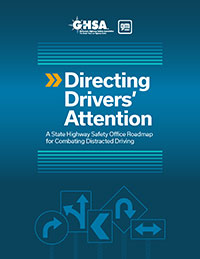 Distracted driving is a critical safety issue on our roads that doesn’t always get the attention it deserves. To raise awareness of this problem and offer solutions, GHSA and General Motors released a new report last month with a singular goal: Change the social norm around distracted driving to make it completely unacceptable so that all road users get home safely. Directing Drivers’ Attention: A State Highway Safety Office Roadmap for Combating Distracted Driving examines the extent of the problem and provides more than two dozen recommendations to help State Highway Safety Offices (SHSOs) and their partners combat this deadly driving behavior. For a deeper dive into the report and its findings, GHSA hosted a July 16 webinar where staff provided a high-level overview of distracted driving, shared key report recommendations and issued a call to action for SHSOs. Watch a recording of the webinar on the GHSA website. GHSA and GM are offering $210,000 in grants for SHSOs to implement recommendations in the report, support new initiatives and/or expand successful programs.
Distracted driving is a critical safety issue on our roads that doesn’t always get the attention it deserves. To raise awareness of this problem and offer solutions, GHSA and General Motors released a new report last month with a singular goal: Change the social norm around distracted driving to make it completely unacceptable so that all road users get home safely. Directing Drivers’ Attention: A State Highway Safety Office Roadmap for Combating Distracted Driving examines the extent of the problem and provides more than two dozen recommendations to help State Highway Safety Offices (SHSOs) and their partners combat this deadly driving behavior. For a deeper dive into the report and its findings, GHSA hosted a July 16 webinar where staff provided a high-level overview of distracted driving, shared key report recommendations and issued a call to action for SHSOs. Watch a recording of the webinar on the GHSA website. GHSA and GM are offering $210,000 in grants for SHSOs to implement recommendations in the report, support new initiatives and/or expand successful programs.
Speeding has been a major risk to road safety for decades and the problem has only worsened during the pandemic. Last year, GHSA partnered with the Insurance Institute for Highway Safety and the National Road Safety Foundation to fund and evaluate pilot projects to slow drivers down. The first results from this initiative are in, and they’re extremely promising. A combination of high visibility enforcement, public outreach and engineering changes on a stretch of rural road in Bishopville, Md., was successful in encouraging safer driving. Over the duration of the project, data showed that average speeds fell 9%. The IIHS analysis also found a 78% reduction in the odds that a vehicle exceeded the speed limit by any amount. However, those effects were temporary as travel speeds returned to pre-pilot levels once the demonstration project concluded. Clearly, the project confirmed the safety benefit of sustained public outreach, enforcement and permanent engineering treatments. The second pilot project, in Virginia, is slated to begin later this year.
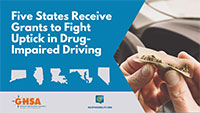 With impaired driving skyrocketing during the pandemic, GHSA and Responsibility.org have partnered yet again to provide states with resources to combat multi-substance impaired driving. We’ve awarded $130,000 in grants to five states to bolster their ability to deter and detect impaired drivers by conducting a series of “green labs,” implementing a first-of-its-kind on-call toxicology program that can be a model for other states, providing equipment to expand the range of impairing drugs tested by toxicology labs and other initiatives. Now in its eighth year, the GHSA and Responsibility.org grant program has provided nearly $1 million to states to address alcohol- and drug-impaired driving. I’m especially proud of this long-running partnership and look forward to its continued success.
With impaired driving skyrocketing during the pandemic, GHSA and Responsibility.org have partnered yet again to provide states with resources to combat multi-substance impaired driving. We’ve awarded $130,000 in grants to five states to bolster their ability to deter and detect impaired drivers by conducting a series of “green labs,” implementing a first-of-its-kind on-call toxicology program that can be a model for other states, providing equipment to expand the range of impairing drugs tested by toxicology labs and other initiatives. Now in its eighth year, the GHSA and Responsibility.org grant program has provided nearly $1 million to states to address alcohol- and drug-impaired driving. I’m especially proud of this long-running partnership and look forward to its continued success.
I’m excited to see many of you again in Louisville this September. Until then, I hope you stay safe and have a great summer.
Look for us!GHSA is on the road speaking about an array of traffic safety issues at conferences around the country. We look forward to seeing you at these meetings: NASID: July 27-29 in Washington, DC. Jonathan will speak during the opening session, a panel featuring GHSA Chair Chuck DeWeese will discuss an upcoming report on cannabis consumers and safe driving messaging, and Russ Martin will speak on a panel about the Safe System approach and moderate a separate discussion about equity in impaired driving prevention. ITE: July 31 - August 3 in New Orleans, LA. Jonathan Adkins will speak on a panel titled "Using the Safe System Approach to Improve Safety for All Road Users" on August 2. ATSIP: August 7-10 in Denver, CO. Jonathan will participate in a keynote panel about how traffic records fit into the Safe System approach on August 8. 9th Annual National Distracted Driving Summit: August 18-19 in Norfolk, VA. Pam Shadel Fischer will discuss how to direct drivers' attention to the road and develop a plan for combating distracted driving with survivor advocate Jennifer Smith on August 18. |
Welcome New Members
GHSA is pleased to welcome the following new Associate Members. Click on each to learn about their mission and services:
- Agate Software
- American Honda Motor Company
- Audi of America
- Brown-Forman
- David Ennis
- David I. Fuchs, Injury & Accident Lawyer, P.A.
- Dolman Law Group
- Driving in the Real World
- Hensley Legal Group
- Heritage Environmental Services, LLC
- Iliago, LLC
- Kentucky Distillers' Association
- Kirk Kerkorian School of Medicine at UNLV
- Kustom Signals, Inc.
- Maus Law Firm
- Nuro Inc.
- PursuitAlert Digital Siren
- The Keri Anne DeMott Foundation

 With the federal enactment of last year’s Infrastructure Investment and Jobs Act (IIJA), also known as the Bipartisan Infrastructure Law, GHSA and the U.S. Department of Transportation (DOT) are now in a time of transition that offers many new opportunities. With Dr. Steve Cliff’s confirmation on May 26, NHTSA has an Administrator for the first time in more than five years. U.S. DOT and NHTSA are also focused on implementing the new National Roadway Safety Strategy and many of the infrastructure bill’s highway safety provisions, including updating the rules governing NHTSA’s highway safety grant programs.
With the federal enactment of last year’s Infrastructure Investment and Jobs Act (IIJA), also known as the Bipartisan Infrastructure Law, GHSA and the U.S. Department of Transportation (DOT) are now in a time of transition that offers many new opportunities. With Dr. Steve Cliff’s confirmation on May 26, NHTSA has an Administrator for the first time in more than five years. U.S. DOT and NHTSA are also focused on implementing the new National Roadway Safety Strategy and many of the infrastructure bill’s highway safety provisions, including updating the rules governing NHTSA’s highway safety grant programs.
The state Highway Safety Plans (HSPs) submitted to NHTSA this month are the last to be organized under the prior FAST Act rules; next year’s HSPs for Federal Fiscal Year 2024 will be triennial plans organized under the IIJA. On May 2, 4 and 5, NHTSA welcomed safety partners to participate in virtual stakeholder meetings on the agency’s plans to develop new rules for triennial HSPs and related program details. GHSA and several states presented during the virtual events and GHSA subsequently submitted detailed written comments.
NHTSA aims to release a Notice of Proposed Rulemaking – a full draft set of rules – in the second half of the year in order to complete a new Final Rule by December 31. GHSA plans to continue to directly engage in this process and to coordinate with key partners.
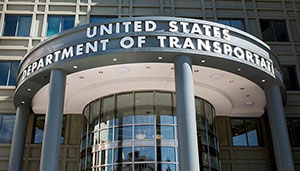 U.S. DOT has also announced a Notice of Funding Opportunity for the new Safe Streets and Roads For All Grant Program, which will provide $1 billion per year in competitive grants directly to local, regional and tribal authorities to support and implement comprehensive safety action plans. States are well positioned to support local partners participating in this new effort.
U.S. DOT has also announced a Notice of Funding Opportunity for the new Safe Streets and Roads For All Grant Program, which will provide $1 billion per year in competitive grants directly to local, regional and tribal authorities to support and implement comprehensive safety action plans. States are well positioned to support local partners participating in this new effort.
GHSA looks forward to a new voluntary technical assistance opportunity from NHTSA to help states more effectively tackle the recent increases in fatal crashes. NHTSA will be offering states an in-depth analysis of state crash data and will support state efforts to organize state-level stakeholder roundtables.
NHTSA will soon launch an effort directed by the IIJA to collaborate with GHSA to revisit and update its 2008 Traffic Safety Performance Measures for States and Federal Agencies, which outlines the performance measures state highway safety programs are required to use.
NHTSA also has efforts underway to improve the quality of traffic safety data. The agency is beginning work on the 6th edition of the Model Minimum Uniform Crash Criteria (MMUCC). NHTSA is also planning a new, separate grant to states to improve state crash data systems and support efforts to electronically share crash data.
With traffic deaths increasing, GHSA will continue to advocate for ongoing federal funding, resources and leadership to empower all stakeholders to advance highway safety.

Ford Driving Skills for Life Arrives in DC Area
Several members of the GHSA staff attended the Ford Driving Skills for Life event at Dulles International Airport, just outside the nation’s capital, on May 21-22. More than 450 teens and caregivers participated in hands-on sessions designed to convey the critical safety skills associated with hazard recognition, vehicle handling, and speed and space management, as well as learn about the danger of distracted and impaired driving. Teens and their parents also got a chance to see first-hand how the Driver Alcohol Detection System for Safety (DADSS) can automatically detect when a driver is intoxicated. Special guests included Director Gabriel Robinson with the District of Columbia Department of Motor Vehicles, who spoke at the kickoff on Saturday. The tour’s next stop is in Colorado Springs, July 30-31.
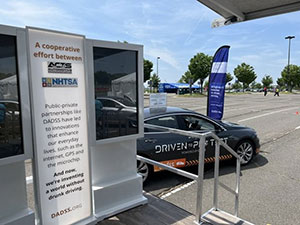
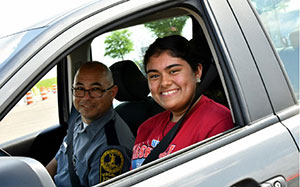
Responsibility.org and GHSA Help Five States Fight Drug- and Alcohol-Impaired Driving
GHSA and the Foundation for Advancing Alcohol Responsibility (Responsibility.org) have teamed up for the eighth year in a row to award grants to fund proven programs that will help deter and detect alcohol- and drug-impaired drivers. A total of $130,000 in grants have been awarded to Connecticut, Illinois, Louisiana, Maryland and Nevada. The program has provided a cumulative total of nearly $1 million in unrestricted funding to states.
The 2022 grants will be applied toward several initiatives. Connecticut and Maryland are funding “green labs,” where volunteers are given controlled doses of marijuana (and sometimes alcohol) and law enforcement officers can perform sobriety tests and witness the impairing effects of these substances.
Louisiana is using its funds for two programs: for a first-of-its-kind, on-call forensic toxicologist who can provide analysis and court testimony in areas of the state that currently lack these resources, and for the purchase of equipment to expand the range of drugs that can be tested in the state. Meanwhile, Illinois will fund a program that will enable the state to test for synthetic opioids in drivers arrested for impaired driving.
Nevada is using its grant to train judges and case managers to use the Computerized Assessment Referral System (CARS). This tool is designed to help identify substance use disorders and an array of mental health issues, so that a judge can make a more informed sentencing decision that includes personalized treatment recommendations specific to the offender.
Each state’s project echoes the recommendations published in the 2019 GHSA report on high-risk impaired driving, funded by Responsibility.org, which calls for an individualized approach to impaired driving. This approach seeks to identify the root cause of the offender's behavior and provide the appropriate sanctions and monitoring that will reduce the likelihood of repeat offenses.
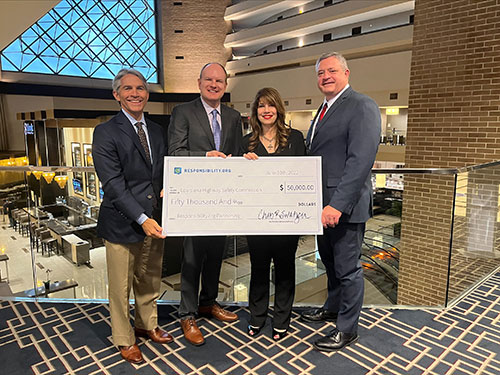
Darrin Grondel recently presented the grant award to Louisiana
Highway Safety Commission Executive Director Lisa Freeman
in New Orleans
Ford, GHSA Present Awards at FCCLA Conference
Every year Family, Career and Community Leaders of America, Inc. (FCCLA) holds a national conference where thousands of students and their advisors from chapters across the nation come together to learn and network as well as showcase member projects and honor outstanding achievement. For the first time, FCCLA awarded Access Scholarships, sponsored by GHSA and Octane Public Relations, that enabled three students and their chapter advisers to attend the 2022 conference held last month in San Diego.
 GHSA and Ford also support FCCLA’s Families Acting for Community Traffic Safety (FACTS) program, a classroom curriculum designed to promote student involvement in community-based traffic safety projects directed to their peers, family members and others. Chapters are invited to submit their traffic safety projects for judging at the state level, which includes input from the highway safety office. From the top winners in each state, national middle and high school awards were presented at the conference along with the Road Safety Achievement Award.
GHSA and Ford also support FCCLA’s Families Acting for Community Traffic Safety (FACTS) program, a classroom curriculum designed to promote student involvement in community-based traffic safety projects directed to their peers, family members and others. Chapters are invited to submit their traffic safety projects for judging at the state level, which includes input from the highway safety office. From the top winners in each state, national middle and high school awards were presented at the conference along with the Road Safety Achievement Award.
GHSA Vice Chair Barbara Rooney and GHSA Executive Director Jonathan Adkins were in San Diego to recognize the scholarship and FACTS award winners during the opening session, with Ford Program Manager Nolan Katerberg providing video remarks. See the reactions of scholarship winners!
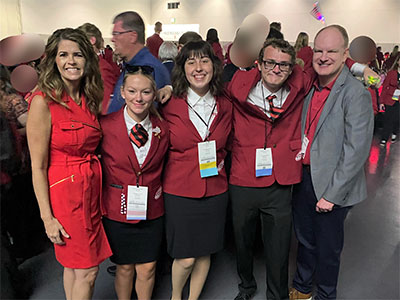

Ohio Teams with CHOP to Assess Novice Driver Licensing, Education and Training Requirements
 A new study conducted in Ohio by the Center for Injury Research and Prevention at the Children’s Hospital of Philadelphia (CHOP) confirms the value of comprehensive Graduated Driver Licensing (GDL) programs that include driver education. According to CHOP researchers, new drivers licensed before age 18 who are subject to mandatory driver education that includes behind the wheel training and GDL restrictions were less likely to crash than drivers licensed at age 18 who are exempt from these requirements.
A new study conducted in Ohio by the Center for Injury Research and Prevention at the Children’s Hospital of Philadelphia (CHOP) confirms the value of comprehensive Graduated Driver Licensing (GDL) programs that include driver education. According to CHOP researchers, new drivers licensed before age 18 who are subject to mandatory driver education that includes behind the wheel training and GDL restrictions were less likely to crash than drivers licensed at age 18 who are exempt from these requirements.
In Ohio, drivers under age 18 are required to complete behind the wheel training in addition to GDL requirements, while drivers 18 and older are not. The study found that drivers who were licensed at age 18, making them exempt from comprehensive licensing requirements, had the highest crash rates in the first year of licensure of all those licensed under age 25. Compared with drivers licensed at age 18, those licensed at age 16 had 27% lower crash rates during the first two months of holding a license and 14% lower crash rates during the first 12 months of licensure. Compared with drivers licensed at 18, those licensed at age 17 had 19% lower crash rates over the first two months of licensure and 6% lower crash rates over the first 12 months of licensure. In addition, 16-year-old license applicants performed best on the on-road license exam of all those licensed under the age of 25, with a 22% failure rate compared with a 37% failure rate at age 18.
The study shows that we shouldn’t assume the youngest new drivers will have the highest crash rates. Comprehensive licensing requirements can help them perform better than their older counterparts who are exempt from these same requirements. To learn more about CHOP’s research in Ohio, be sure to attend the teen driving workshop at the GHSA 2022 Annual Meeting in Louisville this September.

Multifaceted Project in Maryland Succeeds in Slowing Drivers
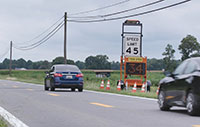 A combination of enforcement, low-cost engineering and public outreach successfully reduced speeding during a demonstration project aimed at combatting one of the most persistent and deadly roadway safety problems. The effort in Bishopville, described in detail in a report by the Maryland Department of Transportation (MDOT) Motor Vehicle Administration’s Highway Safety Office, focused on a 2.4-mile section of road (MD 367) that is a popular route for beachgoers in the summer months and is known to have a speeding problem.
A combination of enforcement, low-cost engineering and public outreach successfully reduced speeding during a demonstration project aimed at combatting one of the most persistent and deadly roadway safety problems. The effort in Bishopville, described in detail in a report by the Maryland Department of Transportation (MDOT) Motor Vehicle Administration’s Highway Safety Office, focused on a 2.4-mile section of road (MD 367) that is a popular route for beachgoers in the summer months and is known to have a speeding problem.
During the pilot project, average speeds fell 9% and the odds that a vehicle on the road was speeding dropped by 78%. There was also broad public awareness of the program. In surveys conducted as part of the study, drivers in the area were asked how likely speeders would be stopped by police. Drivers who said it was likely or very likely increased from 47% before the program to 67% after its launch. At the same time, drivers in Bishopville and neighboring communities who said speeding was a major problem on MD 367 declined from 31% to 7%. The effects significantly decreased once the measures were discontinued.
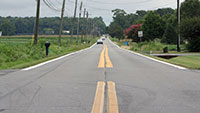 The Maryland project was funded by a $100,000 grant from GHSA, the Insurance Institute for Highway Safety (IIHS) and the National Road Safety Foundation (NRSF). The three organizations partnered to fund and evaluate comprehensive speed management pilot programs in one rural and one urban location. The urban project, planned for Virginia, is expected to begin later this year.
The Maryland project was funded by a $100,000 grant from GHSA, the Insurance Institute for Highway Safety (IIHS) and the National Road Safety Foundation (NRSF). The three organizations partnered to fund and evaluate comprehensive speed management pilot programs in one rural and one urban location. The urban project, planned for Virginia, is expected to begin later this year.
To learn more about the Maryland project, be sure to attend the speeding workshop at the GHSA 2022 Annual Meeting this September in Louisville.
New Study Shows Traffic Enforcement Improves Road Safety
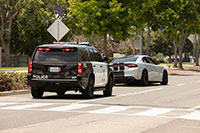 A recently released NHTSA research report synthesizes data from 80 studies to examine the relationship between high visibility enforcement (HVE) and traffic safety outcomes, confirming that enforcement of speeding; not buckling up; and drunk, drugged and distracted driving does make a difference in reducing these dangerous driving behaviors.
A recently released NHTSA research report synthesizes data from 80 studies to examine the relationship between high visibility enforcement (HVE) and traffic safety outcomes, confirming that enforcement of speeding; not buckling up; and drunk, drugged and distracted driving does make a difference in reducing these dangerous driving behaviors.
Researchers sought to quantify the specific relationship between the intensity or amount of enforcement and the magnitude of observed safety impacts. Seat belt use law enforcement was found to produce on average a 3.5% improvement in belt use rates. One additional checkpoint per 100,000 people per week increased the belt use rate by 0.76 percentage points, according to the analysis. The synthesis concluded that enforcement campaigns were effective at reducing all prohibited behaviors, although the magnitude of the observed safety improvements for the other behaviors could not be predicted by the level of enforcement activity used in the effort.
“This study reinforces the need for equitable traffic enforcement focused on the most dangerous driving behaviors,” GHSA Executive Director Jonathan Adkins said in a GHSA news release promoting the research. “Over the past two years, traffic enforcement has declined in many parts of the country while traffic deaths surged.”
The full report and Traffic Tech summary are both available on NHTSA’s website.
New AAA Toolkit: Use of Oral Fluid to Detect Drugged Drivers
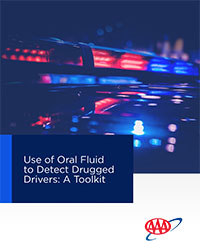 A new report and toolkit developed by AAA is designed to assist policymakers, criminal justice experts and toxicology professionals start or expand oral fluid programs designed to detect drugged drivers at roadside. The extensive report includes detailed information on screening tools, laboratory confirmation and oral fluid in the courts. AAA also developed an oral fluid pocket card for use by law enforcement. An informational flyer provides an overview of the toolkit.
A new report and toolkit developed by AAA is designed to assist policymakers, criminal justice experts and toxicology professionals start or expand oral fluid programs designed to detect drugged drivers at roadside. The extensive report includes detailed information on screening tools, laboratory confirmation and oral fluid in the courts. AAA also developed an oral fluid pocket card for use by law enforcement. An informational flyer provides an overview of the toolkit.
New Report Examines State Law Enforcement Liaison Programs
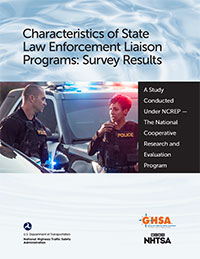 A National Cooperative Research and Evaluation Program (NCREP) report examined the characteristics of state Law Enforcement Liaison (LEL) Programs by surveying LELs and their SHSO program managers. The report details the survey findings and includes almost 40 tables presenting LEL and SHSO views on LEL activities and law enforcement engagement. By understanding LEL programs across the U.S. and the characteristics of an effective LEL - superior communication and interpersonal skills, knowledge of state traffic safety laws and general police methods, connections with law enforcement agencies, and high energy and charisma – states can strengthen and maximize their programs’ impact in engaging with law enforcement agencies.
A National Cooperative Research and Evaluation Program (NCREP) report examined the characteristics of state Law Enforcement Liaison (LEL) Programs by surveying LELs and their SHSO program managers. The report details the survey findings and includes almost 40 tables presenting LEL and SHSO views on LEL activities and law enforcement engagement. By understanding LEL programs across the U.S. and the characteristics of an effective LEL - superior communication and interpersonal skills, knowledge of state traffic safety laws and general police methods, connections with law enforcement agencies, and high energy and charisma – states can strengthen and maximize their programs’ impact in engaging with law enforcement agencies.
Member Spotlight
GHSA appreciates the support of our Associate Members, who are committed to working with us to achieve a zero fatalities goal. This month, we're featuring Rekor's Paul-Matthew Zamsky and Virginia Tech Transportation Institute's Matt Camden and Scott Tidwell.
Want to be featured in the next issue of Directions? Email Kerry Chausmer.

 Pam O'Donnell
Pam O'Donnell
Catch You Later Foundation
What is an advocate? One that argues for a cause, a supporter or a defender.
On February 22, 2016, I had to make the choice of either rising up and fighting for my husband and 5-year-old daughter who were killed by an impaired driver or sitting back and accepting that “it just happens.” I decided to do the former and be a voice for change.
I knew the path I had to take started with law enforcement, so I began talking with law enforcement officials. Through many conversations, I have since learned it is critical to talk with police recruits before they finish the academy and take the oath. Often, a new officer is partnered up with a “seasoned professional,” who may be disenfranchised with the system or have the mindset that “the violation will only amount to a mere traffic summons that will no doubt be downgraded or merged into a lesser violation.” The latter may prompt a “why bother attitude,” which is then adopted by the new officer. The field training officer must be experienced and exemplify the best of the agency, represent the profession in the highest manner and strive to provide the community with quality law enforcement services.
Recruits must be taught that they will see firsthand, and almost daily, motor vehicle violations such as speeding, districted and impaired driving, and the devastation this dangerous behavior causes as they work crash scenes. Laws were written to protect the safety of all road users and it is up to law enforcement to ensure they are enforced consistently and objectively. It is their responsibility to conduct thorough investigations and cite the violators appropriately. It is the court’s responsibility to determine the outcome of the citations. A recently released report confirmed that traffic enforcement saves lives.
Through conversations with law enforcement, I was invited by the New Jersey Police Training Commission (NJ PTC) to become a certified Police Instructor (PTC). I successfully completed the training program, formalized my advocacy alongside police officers and am now qualified to instruct recruits at various NJ police academies. I was the first “outsider” to do so, and I hope not the last. As a certified Police Instructor, I utilize both my professional and personal experiences to educate the next generation of law enforcement officers about distracted and impaired driving, the importance of writing citations when appropriate and the long-term effects crashes have on the survivors. The impact of survivor advocates sharing their personal stories adds a level of humanity, intimacy and loss that regular law enforcement training cannot.
By partnering with first responders, I share my personal experiences from that tragic day, present car crash simulations at high schools and regularly participate in community outreach programs. I’m in constant contact with law enforcement, as they recognize the important partnerships we created to help make our communities safer. By working together and having honest and thoughtful conversations, we support our shared passion and desire to bring an end to the tragedies caused by distracted and impaired driving. There is no room for egos in this relationship. The cost of a human life is far too great. By working together to achieve this shared goal, we are changing the narrative.


